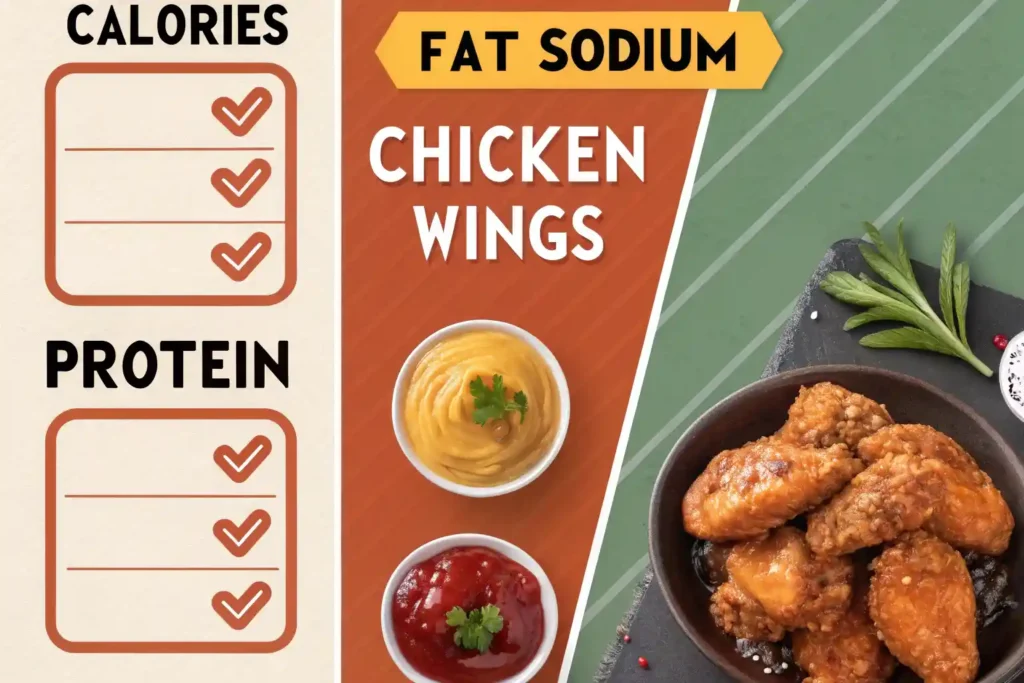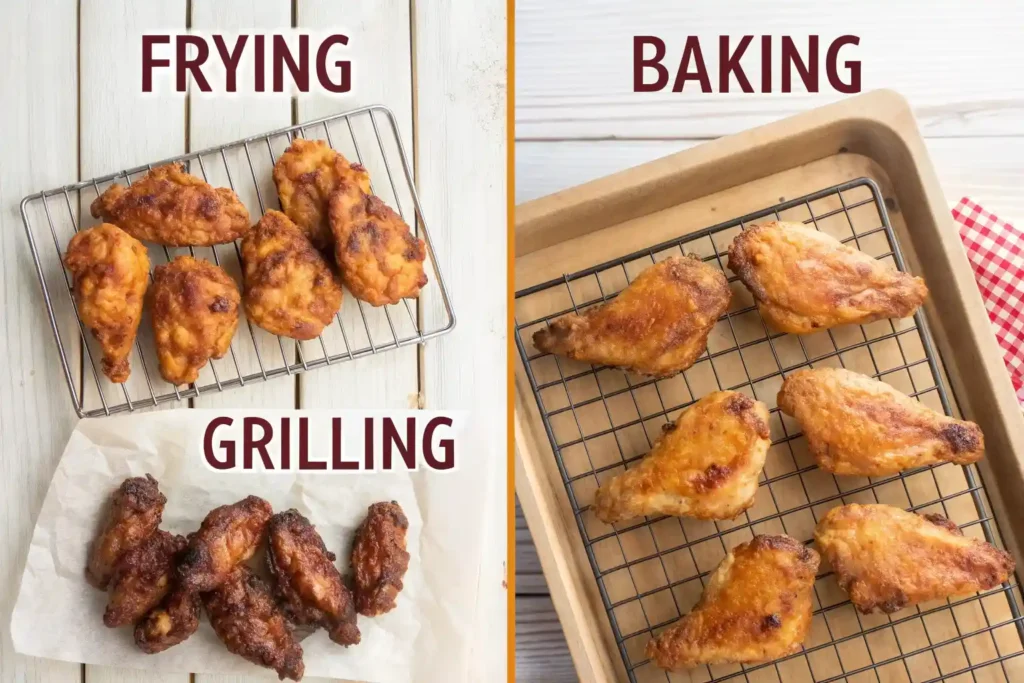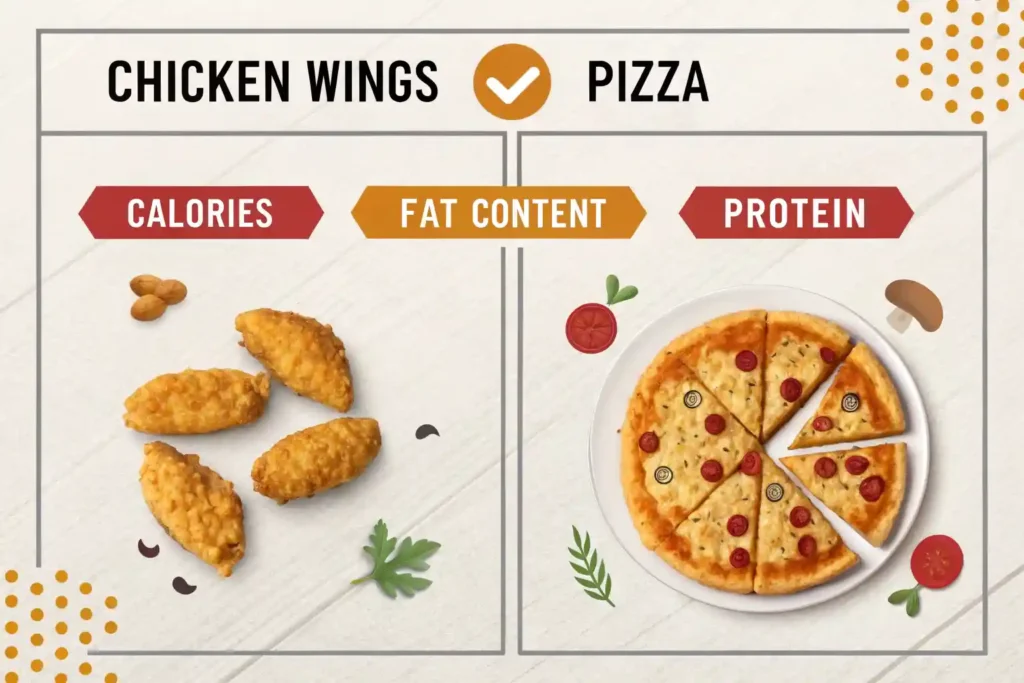Table of contents
1. Are Chicken Wings Unhealthy to Eat?
When it comes to popular snacks, chicken wings often take center stage. However, many people wonder, are chicken wings unhealthy to eat? The answer isn’t straightforward, as it depends on various factors, including preparation methods, portion sizes, and individual dietary needs.
Nutritional Breakdown
- Calories: A typical serving of fried chicken wings (about 4-5 wings) can contain anywhere from 400 to 600 calories. This can vary significantly based on the cooking method and any sauces used.
- Fats: Chicken wings are often high in fat, particularly saturated fat, especially when fried. A serving can contain around 25-30 grams of fat, which is a considerable portion of the daily recommended intake.
- Protein: On the positive side, chicken wings are a good source of protein, providing about 20-25 grams per serving, which is beneficial for muscle repair and growth.
Health Risks
While chicken wings can be a tasty treat, they come with potential health risks:
- High Sodium Content: Many sauces, especially buffalo and barbecue, are loaded with sodium. A single serving can contain over 1,000 mg of sodium, which can contribute to high blood pressure and other cardiovascular issues.
- Unhealthy Fats: The frying process can introduce trans fats, which are linked to heart disease. Opting for baked or grilled wings can mitigate this risk.
- Caloric Density: Due to their high calorie and fat content, chicken wings can contribute to weight gain if consumed in excess.
Comparative Analysis
When comparing chicken wings to other popular snacks, such as potato chips or nachos, wings can be healthier if prepared properly. However, the key is moderation and making informed choices about preparation methods and portion sizes.
2. Are Chicken Wings OK for Weight Loss?

For those on a weight loss journey, the question arises: are chicken wings ok for weight loss? The answer is nuanced and depends on how they fit into your overall diet.
Caloric Considerations
- Portion Sizes Matter: Eating a small portion of chicken wings can fit into a weight loss plan, but large servings can quickly lead to exceeding daily caloric needs.
- Tracking Intake: Keeping track of your caloric intake can help you enjoy chicken wings without derailing your weight loss efforts. Apps and food diaries can be useful tools.
Healthy Cooking Methods
- Baking vs. Frying: Baking chicken wings instead of frying can significantly reduce their calorie and fat content. Baked wings can be just as crispy and flavorful when seasoned properly.
- Grilling: Grilling is another healthy option that adds flavor without the extra calories from frying.

Incorporating Wings into a Diet
- Balance is Key: If you enjoy chicken wings, consider balancing them with healthier sides, such as vegetable sticks or a salad. This can help create a more nutritious meal.
- Choose Sauces Wisely: Opt for lighter sauces or marinades, such as lemon juice or vinegar-based dressings, to keep calories in check.
3. Are Bone-In Wings Unhealthy?
Another common question is: are bone-in wings unhealthy? Understanding the differences between bone-in and boneless wings can help clarify this issue.
Nutritional Differences
- Bone-In vs. Boneless: Bone-in wings typically contain more natural flavor and moisture, while boneless wings are often made from processed chicken meat. This can lead to differences in nutritional value.
- Caloric Content: Bone-in wings generally have a similar caloric content to boneless wings, but the latter may contain added fillers and preservatives that can affect overall health.
Preparation Methods
- Impact of Sauces: The healthiness of bone-in wings largely depends on the sauces used. Creamy or sugary sauces can add unnecessary calories and fats.
- Cooking Techniques: As with traditional wings, the method of cooking plays a significant role. Baking or grilling bone-in wings is a healthier option compared to frying.
Healthier Alternatives
- Skinless Options: If you’re concerned about fat content, consider removing the skin from bone-in wings before cooking. This can significantly reduce calories and fat.
- Homemade Sauces: Making your own sauces can help control ingredients and avoid excess sugars and preservatives.
4. Are Wings Healthier Than Pizza?

When it comes to choosing between two beloved snacks, many people wonder: are wings healthier than pizza? Both options can be indulgent, but understanding their nutritional profiles can help you make a more informed choice.
Nutritional Comparison
- Calories: A typical serving of chicken wings (about 10 wings) can range from 600 to 1,200 calories, depending on preparation and sauces. In contrast, a slice of pizza can contain 200 to 300 calories, with a whole pizza easily exceeding 2,000 calories.
- Fats: Chicken wings often have higher fat content, especially if fried. A serving can contain 25-30 grams of fat, while a slice of pizza may have around 10-15 grams.
- Protein: Wings are a better source of protein, offering about 20-25 grams per serving, compared to pizza, which typically has less protein unless topped with meat.
Ingredient Quality
- Fresh Ingredients: Pizza can be made with fresh vegetables and lean meats, which can enhance its nutritional value. However, many commercial pizzas use processed ingredients that can be high in sodium and unhealthy fats.
- Processed vs. Whole Foods: Chicken wings, especially when made from whole chicken parts, can be less processed than some pizza options, particularly those with pre-packaged crusts and sauces.
Dietary Preferences
- Gluten-Free Options: For those with gluten sensitivities, chicken wings can be a safer choice, especially when prepared without breading. Pizza, unless specifically made gluten-free, can pose a risk.
- Customization: Both wings and pizza can be customized to be healthier. Opting for baked wings and whole-grain or cauliflower crust pizza can make either option more nutritious.
5. How Many Calories Are in 10 Chicken Wings?
A common question among wing lovers is: how many calories are in 10 chicken wings? The answer can vary based on several factors, including cooking method and sauce.
Caloric Breakdown
- Fried Wings: On average, 10 fried chicken wings can contain between 800 to 1,200 calories. This range depends on the size of the wings and the type of oil used for frying.
- Baked Wings: If you opt for baked wings, the calorie count can drop significantly, often ranging from 600 to 900 calories for the same serving size.
- Sauces: The type of sauce can also impact the calorie count. For example, a serving of buffalo sauce can add an additional 100-200 calories, while a lighter vinegar-based sauce may add fewer calories.
Factors Affecting Calories
- Size of Wings: Larger wings will naturally have more calories than smaller ones.
- Preparation Method: Baking or grilling wings instead of frying can significantly reduce calorie content.
- Portion Control: Being mindful of portion sizes can help manage caloric intake. Consider sharing a plate of wings or opting for a smaller serving.
Tracking Intake
- Using Apps: Many food tracking apps can help you log your caloric intake, making it easier to enjoy chicken wings while staying within your dietary goals.
- Reading Labels: If you purchase pre-packaged wings or sauces, always check the nutritional labels for accurate calorie counts.
6. Which is Healthier: Wings or Thighs?
Another common question is: which is healthier, wings or thighs? Both cuts of chicken have their pros and cons, and understanding their nutritional profiles can help you make a better choice.
Nutritional Comparison
- Calories: Chicken thighs generally have a higher calorie content than wings. A serving of cooked chicken thighs can contain around 250-300 calories, while wings typically range from 100-150 calories per wing.
- Fat Content: Thighs tend to have more fat, with about 20-25 grams per serving, compared to wings, which can have around 15-20 grams.
- Protein: Both wings and thighs are good sources of protein, but thighs may offer slightly more per serving.
Cooking Methods
- Preparation Impact: The healthiness of both wings and thighs can be affected by how they are cooked. Grilling or baking is healthier than frying, regardless of the cut.
- Skin On vs. Skin Off: Removing the skin from thighs can significantly reduce fat and calorie content, making them a healthier option.
Personal Preferences
- Taste and Texture: Some people prefer the flavor and texture of thighs, while others enjoy the crispy skin of wings. Your personal preference can influence your choice.
- Dietary Needs: If you’re watching your fat intake, wings may be a better option, especially if you choose skinless varieties. Conversely, if you need more protein, thighs might be the way to go.
7. Conclusion and FAQs
In summary, the healthiness of chicken wings largely depends on various factors, including preparation methods, portion sizes, and individual dietary needs. While they can be a delicious and protein-rich snack, it’s essential to be mindful of how they fit into your overall diet. Here’s a recap of the key points discussed:
- Nutritional Value: Chicken wings can be high in calories and fat, especially when fried and served with rich sauces. However, they also provide a good source of protein.
- Weight Loss Considerations: With proper portion control and healthier cooking methods, chicken wings can be included in a weight loss plan.
- Comparative Healthiness: When compared to other snacks like pizza, chicken wings can be healthier if prepared mindfully. Bone-in wings offer a different nutritional profile than boneless wings, and thighs can be a more calorie-dense option.
- Caloric Awareness: Understanding the caloric content of chicken wings, especially when considering sauces and cooking methods, is crucial for making informed dietary choices.
For those looking to explore more about healthy eating, consider checking out articles like Is Indian Food Healthy? for a broader perspective on nutritious cuisines, or learn about convenient options with Healthy Choice Frozen Meals. If you’re interested in other chicken recipes, the Healthy Chicken Pot Pie can provide a wholesome alternative.
FAQs
- Are chicken wings unhealthy to eat?
- Chicken wings can be unhealthy if consumed in large quantities or prepared with high-calorie sauces and frying methods. However, they can be part of a balanced diet when prepared healthily.
- Are chicken wings ok for weight loss?
- Yes, chicken wings can be included in a weight loss plan if consumed in moderation and prepared using healthier methods like baking or grilling.
- Are bone-in wings unhealthy?
- Bone-in wings are not inherently unhealthy, but their nutritional value can vary based on preparation and sauces. They can be a healthier option compared to processed boneless wings.
- Are wings healthier than pizza?
- Generally, chicken wings can be healthier than pizza, especially if baked and served with lighter sauces. However, it depends on the specific ingredients and preparation methods used for both.
- How many calories are in 10 chicken wings?
- The calorie count for 10 chicken wings can range from 600 to 1,200 calories, depending on whether they are fried or baked and the type of sauce used.
- Which is healthier: wings or thighs?
- Chicken thighs tend to be higher in calories and fat compared to wings. However, both can be healthy options when prepared properly and consumed in moderation.

